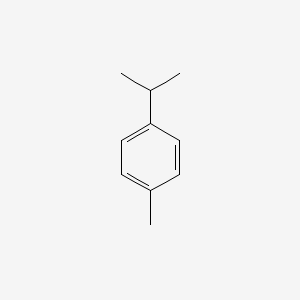| MeSH term | MeSH ID | Detail |
|---|---|---|
| Chemical and Drug Induced Liver Injury | D056486 | 39 associated lipids |
| Dermatomycoses | D003881 | 17 associated lipids |
| Carbon Tetrachloride Poisoning | D002252 | 12 associated lipids |
p-Cymene
P-cymene is a lipid of Prenol Lipids (PR) class. P-cymene is associated with abnormalities such as Abnormal shape. The involved functions are known as Binding (Molecular Function), inhibitors and Oxidation. P-cymene often locates in Cell membrane. The associated genes with p-Cymene are Chromatin, Homologous Gene and ethylbenzene dehydrogenase. The related lipids are Steroids.
Cross Reference
Introduction
To understand associated biological information of p-Cymene, we collected biological information of abnormalities, associated pathways, cellular/molecular locations, biological functions, related genes/proteins, lipids and common seen animal/experimental models with organized paragraphs from literatures.
What diseases are associated with p-Cymene?
p-Cymene is suspected in Abnormal shape and other diseases in descending order of the highest number of associated sentences.
Related references are mostly published in these journals:
| Disease | Cross reference | Weighted score | Related literature |
|---|
Possible diseases from mapped MeSH terms on references
We collected disease MeSH terms mapped to the references associated with p-Cymene
PubChem Associated disorders and diseases
What pathways are associated with p-Cymene
There are no associated biomedical information in the current reference collection.
PubChem Biomolecular Interactions and Pathways
Link to PubChem Biomolecular Interactions and PathwaysWhat cellular locations are associated with p-Cymene?
Visualization in cellular structure
Associated locations are in red color. Not associated locations are in black.
Related references are published most in these journals:
| Location | Cross reference | Weighted score | Related literatures |
|---|
What functions are associated with p-Cymene?
Related references are published most in these journals:
| Function | Cross reference | Weighted score | Related literatures |
|---|
What lipids are associated with p-Cymene?
Related references are published most in these journals:
| Lipid concept | Cross reference | Weighted score | Related literatures |
|---|
What genes are associated with p-Cymene?
Related references are published most in these journals:
| Gene | Cross reference | Weighted score | Related literatures |
|---|
What common seen animal models are associated with p-Cymene?
There are no associated biomedical information in the current reference collection.
NCBI Entrez Crosslinks
All references with p-Cymene
Download all related citations| Authors | Title | Published | Journal | PubMed Link |
|---|---|---|---|---|
| Philis JG | The S1 <-- S0 spectrum of jet-cooled p-cymene. | 2005 | Spectrochim Acta A Mol Biomol Spectrosc | pmid:15741127 |
| Park BS et al. | Monoterpenes from thyme (Thymus vulgaris) as potential mosquito repellents. | 2005 | J. Am. Mosq. Control Assoc. | pmid:15825766 |
| Foti MC et al. | New insight into solvent effects on the formal HOO. + HOO. reaction. | 2005 | Chemistry | pmid:15685709 |
| Li Y et al. | Preparation of polymer-supported Ru-TsDPEN catalysts and use for enantioselective synthesis of (S)-fluoxetine. | 2005 | Org. Biomol. Chem. | pmid:15999182 |
| Kiskó G and Roller S | Carvacrol and p-cymene inactivate Escherichia coli O157:H7 in apple juice. | 2005 | BMC Microbiol. | pmid:15963233 |
| Shabir GA | Method development and validation for the GC-FID assay of p-cymene in tea tree oil formulation. | 2005 | J Pharm Biomed Anal | pmid:15935601 |
| Novakova O et al. | Conformation of DNA modified by monofunctional Ru(II) arene complexes: recognition by DNA binding proteins and repair. Relationship to cytotoxicity. | 2005 | Chem. Biol. | pmid:15664521 |
| Adams JD and Garcia C | Women's health among the Chumash. | 2006 | Evid Based Complement Alternat Med | pmid:16550233 |
| Hazzit M et al. | Composition of the essential oils of Thymus and Origanum species from Algeria and their antioxidant and antimicrobial activities. | 2006 | J. Agric. Food Chem. | pmid:16910725 |
| Marsh KJ et al. | Conflicting demands on detoxification pathways influence how common brushtail possums choose their diets. | 2006 | Ecology | pmid:16937649 |
| Västilä P et al. | The importance of alkali cations in the [{RuCl2(p-cymene)}2]-pseudo-dipeptide-catalyzed enantioselective transfer hydrogenation of ketones. | 2006 | Chemistry | pmid:16440393 |
| Lee K et al. | Identification and expression of the cym, cmt, and tod catabolic genes from Pseudomonas putida KL47: expression of the regulatory todST genes as a factor for catabolic adaptation. | 2006 | J. Microbiol. | pmid:16728956 |
| GarcÃa DA et al. | Allosteric positive interaction of thymol with the GABAA receptor in primary cultures of mouse cortical neurons. | 2006 | Neuropharmacology | pmid:16185724 |
| Papadopoulos CJ et al. | Susceptibility of pseudomonads to Melaleuca alternifolia (tea tree) oil and components. | 2006 | J. Antimicrob. Chemother. | pmid:16735435 |
| Tian H and Lai DM | [Analysis on the volatile oil in Origanum vulgare]. | 2006 | Zhong Yao Cai | pmid:17212048 |
| Pinto E et al. | Antifungal activity of the essential oil of Thymus pulegioides on Candida, Aspergillus and dermatophyte species. | 2006 | J. Med. Microbiol. | pmid:17005785 |
| Choi HS | Lipolytic effects of citrus peel oils and their components. | 2006 | J. Agric. Food Chem. | pmid:16637681 |
| Guarrera PM et al. | Food, flavouring and feed plant traditions in the Tyrrhenian sector of Basilicata, Italy. | 2006 | J Ethnobiol Ethnomed | pmid:16959031 |
| Veldhuizen EJ et al. | Structural requirements for the antimicrobial activity of carvacrol. | 2006 | J. Agric. Food Chem. | pmid:16506847 |
| Nhu-Trang TT et al. | Deuterium/hydrogen ratio analysis of thymol, carvacrol, gamma-terpinene and p-cymene in thyme, savory and oregano essential oils by gas chromatography-pyrolysis-isotope ratio mass spectrometry. | 2006 | J Chromatogr A | pmid:16945376 |
